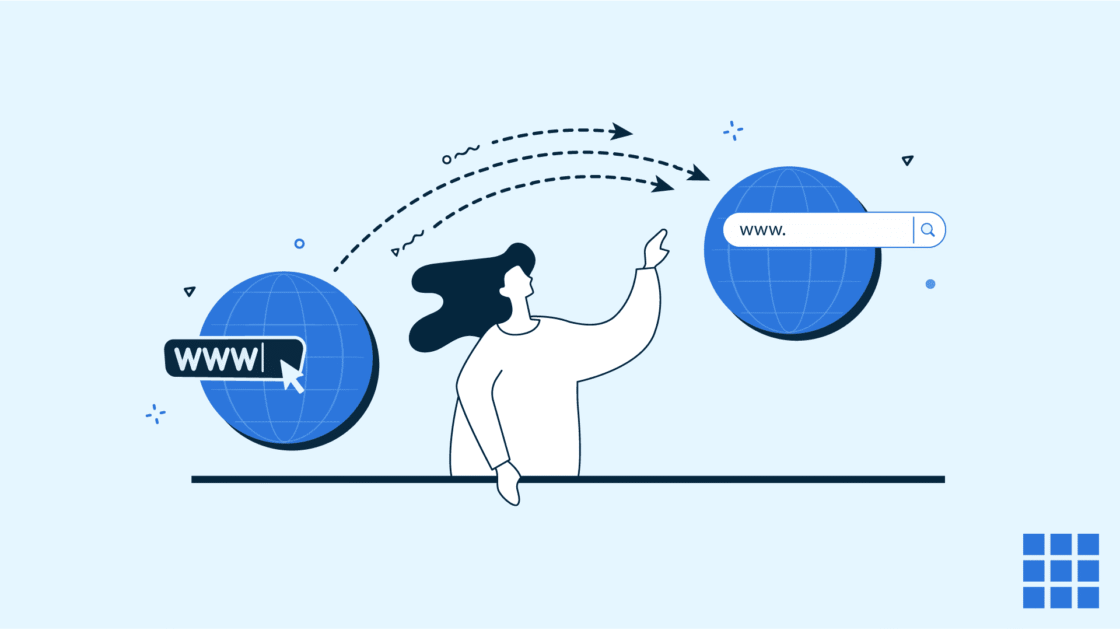Key highlights
- Choosing the right marketplace can help you get noticed and attract real buyers who will pay a fair price.
- A listing that is clear and well-organised can build trust with buyers and increase the chance of a good sale.
- Good negotiation skills help you get a better deal while staying professional.
- WHOIS lookup tools help buyers see ownership and talk with sellers, keeping the negotiation process clear.
Owning a domain name isn’t just about having a website – it can also be a valuable asset. As time goes by, some domains can become more valuable, making them a good investment. But what do you do when a domain is no longer helpful? Whether your business has shifted focus, or a project has ended, selling your domain can turn an unused asset into profit.
Selling a domain is not just about putting it up for sale. To get the best price, you need to determine its value, choose the right marketplace and ensure a secure transaction.
This guide will walk you through the entire process, from pricing your domain to closing the deal with confidence. Whether you’re selling a single domain or exploring domain flipping as a business, these expert tips will help you get the best results when you sell domain names.
Why sell a domain name? Top reasons & benefits
Selling a domain name can be a strategic move, whether you no longer need it or want to turn a profit. There are two main reasons to sell domain names.
First, you might want to sell your domain name if you no longer need it. This can happen if you purchase a domain name and close your business or if you never use the domain name. Instead of letting it go to waste, selling it can help you recoup some of your investment.
Alternatively, you might want to learn how to sell a domain name to make a profit. Buying and selling domain names is referred to as domain trading. Domain selling can be a lucrative business if you build up a solid portfolio of domains. Some domains gain value over time and you can sell them for a good profit.
However, there are some important things to consider before you begin trading. There are risks involved if you plan to turn domain selling into an investment or business. Not all domains sell quickly and their value can fluctuate based on demand, trends and potential trademark issues. So, you must think twice on “should I or can I sell my domain name?”
Also read: How to Buy a Domain and Email for Your New Business
Challenges of selling domain names
As far as commodities go, domains do not have a high level of liquidity. Unlike traditional investments like stocks, selling a domain name can take time, sometimes even months or years. The domain sales process can be long and you should be prepared to wait for offers. Additionally, if a domain is found to infringe on a trademark, you could face legal consequences and may have to forfeit it.
Understanding how to sell domain names in different ways is a useful skill whether you need to sell a few or planning to invest in its long term. If you follow the steps in this guide, you can learn how to sell a domain name safely and for the best price.
How to sell a domain name: step-by-step guide for quick sales
To sell a domain name, first evaluate its value using tools like Estibot or NameBio, set a competitive price and list it on marketplaces like DNTrade or Drop. Next, create a compelling listing with contact info and promote it through a landing page or direct outreach.
Let’s unfold each of these steps in detail.
1. Evaluate your domain’s worth
Before selling your domain name, it’s important to understand its true value. Several factors influence a domain’s worth, including its extension (.com, .net, etc.), the words used, its length and overall demand. Short and easy names with popular words usually sell for more money.
Names that already attract visitors, have good links and a clean history are also more valuable. You should check that your name does not break any trademarks. This will help you avoid legal issues.
To determine your domain’s value, research recent sales of similar domains.
Bluehost domain search tool can show you the prices of names like yours. This helps you spot domain market trends and see their worth. You can also use domain appraisal tools like NameBio or Estibot, which analyse past sales, keyword rankings and market demand to estimate a fair price.
However, automated tools may not always be accurate, so consulting a professional appraiser can provide more precise insights.
Also read: Calculate Domain Worth: Key Factors & Valuation Tools
2. Set your value and price
Domain values vary greatly, from a few AUD to thousands or millions. Understanding what affects how much a domain is worth can help you set a good price and boost your profit.
Domain valuation involves several factors, including:
- Length: Short domains are more valuable.
- Memorability: Easy-to-remember names sell faster.
- TLD (.com, .org, .io, .net): Such domains have a higher value.
- Age: Older domains often rank better in SEO.
- Market demand: High-demand domains sell at a premium.
- Increases value: Trending keywords and brand potential boost worth.
Some of the domain valuation factors are static. However, if you have a domain name similar to a popular brand or topic, its relevance (and value) can skyrocket.
When setting a price, you can choose from different strategies. If you’re entertaining multiple buyers in an auction, you can advertise a lower price to generate interest. Auctions create competition among buyers, which can drive up the final sale price. Alternatively, a fixed price strategy works best for sellers who want a quick sale and a straightforward transaction. A fixed “buy now” price on your domain works best if you want a fast sale. This plan appeals to buyers looking for a simple and easy deal.
Also read: Ultimate List of Top Level Domains (TLDs) and Their Uses
3. Choose the best marketplace for listing your domain
When you’re ready to sell your domain name, there are a few places you can go to sell it. Experienced sellers use various platforms to find buyers, including domain marketplaces and in-person selling.
Some popular domain marketplace websites include DNTrade and Drop. These platforms provide a vast audience of potential buyers and offer different selling methods, such as fixed-price listings, auctions and brokerage services.
DNTrade
DNTrade is one of Australia’s most active domain name forums, connecting domain investors, buyers and sellers across the country. It provides a trusted space for listing .com.au domain names, discussing domain industry trends and networking with others in the Australian digital space. While it isn’t a traditional marketplace, DNTrade is widely used for direct negotiations and private sales. It’s especially valuable for experienced sellers looking to engage with a local, knowledgeable audience.
Drop
Drop is another leading Australian domain name auction platform that specialises in expired and premium .au domain names. It allows users to bid on high-value Australian domains as they become available, making it a go-to marketplace for local investors and businesses.
Drop.com.au is accredited by auDA (Australian domain authority) and ensures compliance with all .com.au eligibility and transfer requirements. Its competitive bidding environment and focus on Australian domains make it ideal for those targeting the local market.
Listing on auction sites can connect you to a marketplace of interested buyers. Additionally, most domain marketplaces offer related services, including valuation assistance, finding a domain broker and financing.
And finally, reach out to people in your network who might be interested in purchasing your domain.
4. Create a compelling domain listing
Your domain name listing is like a store display. The better it looks, the more attention it receives. A well-crafted listing can attract potential buyers and increase the chances of a successful sale.
Create an attractive listing and highlight your domain’s selling points to help stand out from the competition. Mention key factors such as keyword relevance, search volume, backlinks and any traffic the domain receives. Display any metrics or factors that increase your domain’s value (or potential value) on your listing page to increase your chance of selling your domain. Providing clear and valuable information helps buyers understand why your domain is a good investment.
Domain for sale landing pages
If you want to know how to sell a domain name like a professional, then consider creating a landing page for your domain. A dedicated landing page can make it easier for interested buyers to contact you directly.
You can create a landing page by using a URL redirect. Simply put, this causes the domain name you’re selling to redirect to the landing page you created. This way, whenever someone visits your domain, they will instantly see that it is for sale.
A well-optimised landing page with a compelling message can significantly improve your chances of attracting serious buyers and securing the best price for your domain. Display any metrics or factors that increase your domain’s value (or potential value) on your listing page to increase your chance of selling your domain.
5. List your contact information for easy communication
Why learn best way to sell a domain name if potential buyers can’t contact you? Ensuring that interested buyers can easily reach you is essential for a smooth and successful domain sale.
It’s important that potential buyers can quickly get in touch with you. So, make sure your contact information is available on all listings and landing pages. You don’t need to provide extensive details, but at a minimum, include an email address or phone number where buyers can reach you.
In addition to updating your domain listings, you should verify that your WHOIS record is accurate. A WHOIS record identifies the domain owner (also known as the registrant) and provides their contact information. Many buyers check WHOIS records to reach out directly, making it an important part of your selling strategy.
With Bluehost WHOIS Lookup Tool, you can easily check your domain’s WHOIS information and ensure that your contact details are up to date. If you’ve used domain privacy protection, you may need to adjust your settings so potential buyers can see your correct information when they search for your domain.
If you used a private registration service or proxy service when purchasing your domain, update it with your contact information. This step is essential before selling to ensure buyers see the correct details and avoid delays in negotiations.
Keeping your contact information accessible and updated increases your chances of connecting with serious buyers and closing a successful domain sale.
Also Read: WHOIS Domain Lookup: Mastering Its Use for Your Website
6. Negotiate and close the deal
When you find a buyer, you will start negotiating. A solid negotiation plan can help you achieve the best price for your property.
Begin by understanding what the buyer wants. Are they a business looking for a special domain or are they someone who wants to sell it in the future? If you have a fixed price, stick to it, but be open to reasonable offers. If you can discuss the price, start with a higher number to allow room for negotiation.
Tips for successful domain negotiation
- Know the value of your domain: Use market research and appraisal tools to help decide your asking price.
- Be quick and professional in your responses: Fast and clear communication builds trust with buyers.
- Consider counteroffers: If the first offer is too low, suggest a price that is closer to what you want.
- Use an escrow service for safety: Websites like Escrow.com help make sure the transaction is safe. They ensure both sides get what they need before the domain and payment are exchanged.
Finalizing the sale
Once you decide on a price, finish the sale using a secure payment method. Many online stores have ways to handle the payment and transfer the domain. If you are selling it privately, using a safe service can help prevent fraud and make the process easier.
After getting the payment, move the website to the buyer using your domain registry. The buyer will need to begin the process and you’ll need to agree to it. Make sure all steps are completed to change the ownership and finish the sale successfully.
7. Use an escrow device for secure transactions
Handling payments for a domain name sale isn’t as simple as a regular purchase. There’s some trust involved with the transfer.
For example, you can transfer the domain and then trust the buyer will send you the money or the buyer can pay you first and trust that you’ll transfer the domain.
But how to choose which order?
The good news is that you don’t have to take that risk. You can use an escrow service to secure the transaction. An escrow service holds onto the payment until the domain name is transferred. This ensures that both parties fulfil their obligations before money or the domain changes hands.
How escrow services protect your sale?
Escrow services facilitate any type of transfer through an escrow account. In short, an escrow service helps protect both parties from fraud. Most domain marketplaces offer built-in escrow services, providing a seamless and secure process.
If you’re selling privately or using a platform that doesn’t include escrow, you can use third-party services like [Escrow].com.
Choosing the right escrow service
When selecting an escrow service, consider the following:
- Ensure it offers seller protection for intangible goods like domain names.
- Verify its licensing and reputation to avoid escrow scams.
- Check the service fees to understand any costs involved.
Using a legitimate escrow service adds an extra layer of security, making the domain selling process safer and more reliable for both buyers and sellers.
8. Transfer your domain to the new owner
Now that you have chosen an escrow service and made the payment, it’s time to transfer your domain to the new owner. Transferring your domain to Bluehost involves several key steps to ensure a seamless transition.
Here’s a detailed guide:
1. Prepare your domain for transfer
- Review and update contact information: Ensure that your domain’s registrant and administrative contact details are accurate. This is crucial, as these contacts will receive all transfer-related communications.
- Disable domain privacy: If WHOIS privacy protection is enabled, disable it to make your contact information visible during the transfer process.
- Unlock the domain: Domains are often locked to prevent unauthorised changes. Access your current registrar’s dashboard and unlock the domain to permit the transfer.
- Obtain the authorisation code (EPP code): This unique code is required to authorise the transfer. Request it from your current registrar.
Also read: Your Guide to Finding the Best Domain Registrar
2. Initiate the transfer to Bluehost
- Log in to your Bluehost account: Access your Bluehost Account Manager.
- Start the transfer process: Navigate to the ‘Domains’ tab and select ‘Start Transfer’.


- Enter the domain name: Input the domain you wish to transfer and click ‘Submit’.
- Provide the authorisation code: When prompted, enter the EPP code you obtained earlier.
- Configure domain settings: Choose your preferred domain term, update nameservers if necessary and decide on additional features like Domain Privacy.
- Proceed to checkout: Review your cart and complete the payment to initiate the transfer.
3. Approve the transfer
When the transfer request comes through, simply approve it to initiate the process. The request is sent to the admin email on file, so ensure your contact information is up to date. Check your email for the approval request and follow the provided instructions. Once approved, the transfer will begin and may take a few days to complete.
Final thoughts
There are several reasons why you might want to sell a domain name. You might want to make money by buying and selling domain names and benefit from considerable web traffic. Or you could just want to let go of a domain you no longer use. It’s important to learn how to sell a domain name privately and properly.
The process may take a while, so it is important to follow the right steps. You need to pick a safe way to do your deals and stay away from scams. Take time to check the value of your domain. Make sure to list it in the right spot and try to get a good deal. This will help you boost your chances of making a good sale.
If you want to buy, sell or manage domains, Bluehost has the tools and help you need. With our domain registration and web hosting services, setting up your online presence has never been easier.
Visit Bluehost today to get started!
FAQs
Yes, but it depends on demand. If your domain is short, relevant and in demand, it may sell quickly. Otherwise, it could take time. Patience and the right pricing strategy are key.
Domain markets like DNTrade and Drop are great options. List your domain, set a price and attract potential buyers. A well-priced, high-quality domain sells faster.
Prices range from a few dollars to millions. Factors like length, keywords and domain extension affect value. Research recent sales of similar domains to set a competitive price.
They function as online storefronts where you list your domain and buyers can browse, make offers or purchase outright. Marketplaces also handle transactions securely.



Write A Comment